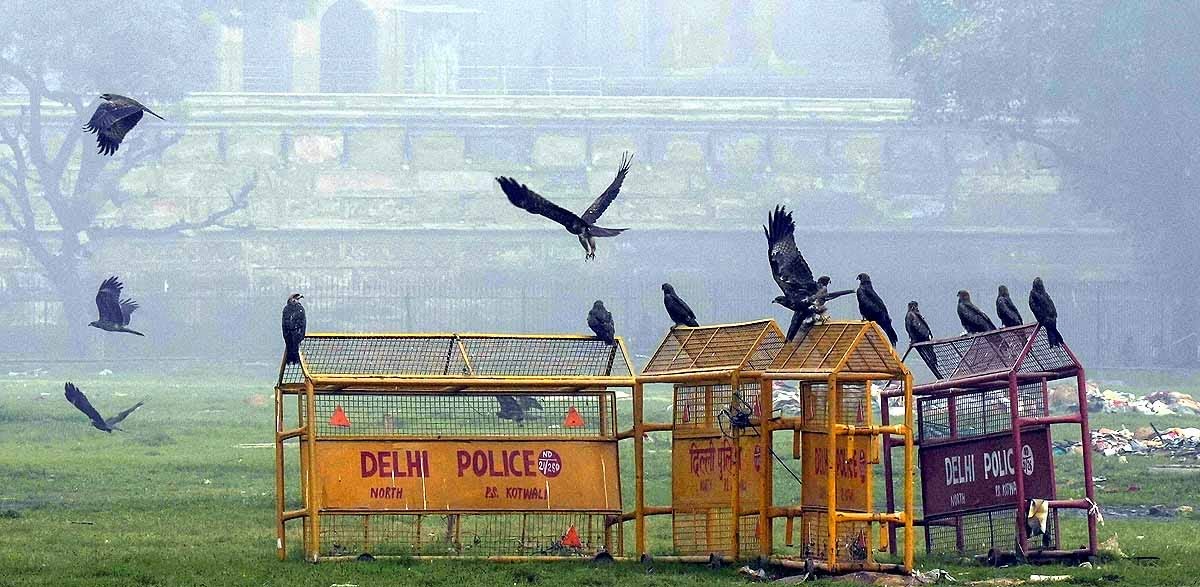Be it Pakistan’s Lahore or India’s capital Delhi, both cities are currently being choked by toxic air. The air has become lethal, and breathing increasingly laborious. In Lahore, the AQI reaches a staggering 1537, while in Delhi's Jahangirpuri, it stands at 606. Over a 24-hour window in Delhi, the AQI was noted as 'severe' across 14 stations.
Lahore has been declared the most polluted city globally. The surrounding areas of Lahore suffer from pollution due to dust, emissions, and smoke. News Agency Reuters reports that this is primarily due to stubble burning in India’s Punjab and Haryana, which impacts both Lahore and Delhi.

Source: aajtak
If both states are contributing to pollution by burning stubble, the weather is also playing a role. Humidity is present, wind speed is sluggish, and temperatures are dropping. These climatic shifts are gradually dispersing dust and smoke, reducing visibility. In fact, airlines have been cautioned to be prepared for diversions due to low visibility at Delhi Airport.
Politics in the Game of Pollution
Last month, the Supreme Court declared that clean air is a fundamental human right and urged the central and state governments to take immediate action. Yet, amidst this pollution, political entities are casting accusations at each other, with ongoing conflicts between central and state governments. Both central and state leaders are hesitant to displease powerful farmers or their groups.

Source: aajtak
Pollution Exceeds WHO Limits Fiftyfold
Currently, Delhi’s pollution levels are fifty times above the limits set by the World Health Organization. Talking about Lahore, the situation there is nightmarish. Not everyone can install air filters at home. The plummeting temperatures and slow-moving winds from mid-October to January tend to trap pollution.
Three Mountains Also Contributing to Pollution
More than 30 million residents of Delhi encountered breathing difficulties on Wednesday morning. The pollution level reached 806 micrograms per cubic meter, with PM 2.5 being 53 times above permissible limits. Besides, the three garbage mountains in Delhi significantly contribute to pollution, emitting poisonous gases that jeopardize the air quality over Delhi-NCR.

Source: aajtak
Top Five Causes of Pollution in Delhi and Lahore
1. Stubble Burning... Initiating Poison Creation
As winter approaches, stubble burning begins in Punjab and Haryana with the remnants of previous harvests being set ablaze. Due to a delayed monsoon, both the clearing and preparation for the next crop started late, extending the duration of stubble burning this year.
2. Wind Direction... Spreading Poison
The direction of the wind plays a significant role in spreading poison in Delhi's air. Factors such as the wind direction, speed, and moisture heavily contribute to the lethal quality of the air in Delhi-NCR. Post-monsoon and pre-winter, winds blowing from Haryana-Punjab towards Delhi carry increased levels of particulate matter.
The wind also carries the toxic smoke from stubble burning. With the post-monsoon air being moist, heavier smog appears all around, compounding the situation. A change in wind direction could potentially improve the conditions.

Source: aajtak
3. Temperature Variation... Amplifying Poison Levels
The consistent temperature alterations during Delhi’s winters also escalate pollution, a phenomenon known as Temperature Inversion. This traps all pollutants near the surface as a layer of warm air overlays cold air. Contributing factors may include vehicle pollution, industries, and stubble burning.
4. Vehicle Emissions... Adding Insult to Injury
Delhi's population is disproportionately high relative to its land area, and vehicle numbers are excessive. Vehicles account for 25% of PM2.5 emissions. Moreover, gases and chemicals emitted from industries in and around Delhi further alter the atmosphere and increase pollution.
5. Other Pollution Sources... Adding to the Woes
Fine dust from arid regions, chemicals and emissions during Diwali fireworks, and household biomass burning intensify winter pollution. An IIT Kanpur study indicates that biomass burning contributes to 17-26% of PM emissions in Delhi-NCR.




